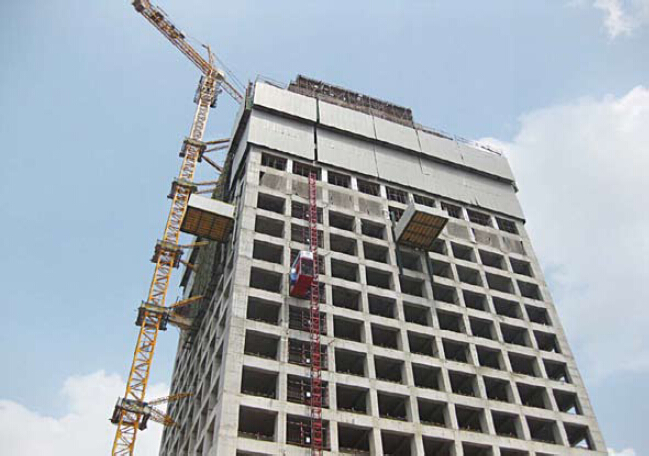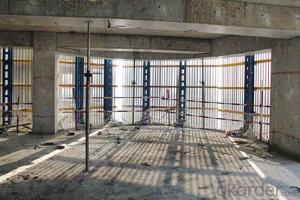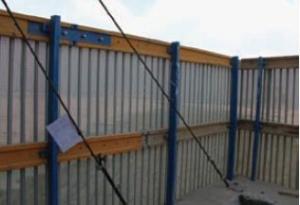Protection-Platform for Formwork and scaffolding system
- Loading Port:
- Tianjin
- Payment Terms:
- TT OR LC
- Min Order Qty:
- 50 m²
- Supply Capability:
- 1000 m²/month
OKorder Service Pledge
OKorder Financial Service
You Might Also Like
Protection Platform PP-50
A kind of new type construction protection system, applying operating platform and safer job
location for construction corps.
Characteristics:
◆ Easy and quick assembling.
◆ Lifted as a group, it is rapid and economic.
◆ Auto-climbing
◆ A safe and reliable anchor system
1. Composition
2. Assembly process of anchor system
(1) Embed V-climbing cone and anchor plate into the slab.
(2) Fix anchor shoe on the slab by tensile bolt.
(3) The fixed anchor shoe.
◆ High work efficiency with work platform and unload platform
◆ High light transmittance with the hollow block


- Q:Is steel formwork suitable for projects with high concrete strength requirements?
- Indeed, steel formwork proves to be a fitting choice for endeavors demanding robust concrete potency. Renowned for its exceptional fortitude and endurance, steel formwork emerges as an ideal candidate for projects necessitating elevated concrete strength. It deftly endures the concrete's pressure and weight, assuring steadfastness and structural integrity throughout the pouring and curing phases. Furthermore, steel formwork grants the concrete a seamless and uniform surface, crucial in attaining superior strength and excellence in the ultimate outcome. Moreover, the reusability of steel formwork renders it a cost-efficient alternative for ventures requiring substantial concrete strength.
- Q:Can steel formwork be used for both above-ground and underground structures?
- Yes, steel formwork can be used for both above-ground and underground structures. Steel formwork is highly durable and can withstand the pressures and conditions of both environments. It provides excellent strength, stability, and reusability, making it suitable for various construction projects regardless of their location.
- Q:How does steel formwork accommodate for different concrete compaction methods?
- Steel formwork accommodates for different concrete compaction methods by providing a rigid and stable structure that can withstand the pressure and vibrations generated during compaction. The steel panels and frames used in formwork are designed to be strong and durable, ensuring that they can handle the forces exerted by different compaction techniques such as vibration, tamping, or mechanical compaction. Additionally, steel formwork can be easily adjusted or customized to suit specific compaction requirements, allowing for precise shaping and consolidation of the concrete.
- Q:How does steel formwork affect the aesthetics of a building?
- Steel formwork can significantly impact the aesthetics of a building in several ways. Firstly, steel formwork allows for complex and intricate designs to be created, resulting in visually appealing architectural elements. The flexibility and strength of steel allow for the construction of unique shapes, curves, and patterns that enhance the overall aesthetics of the building. Additionally, steel formwork provides a smooth and seamless finish to the concrete surfaces. This smooth finish contributes to a more refined and polished look, especially when compared to other types of formwork such as timber or plastic. The absence of visible joints, seams, or imperfections on the concrete surfaces enhances the overall appearance of the building. Moreover, steel formwork can be reused multiple times, resulting in cost savings and reduced waste. This economic advantage allows architects and designers to allocate more resources towards enhancing the aesthetics of the building, such as incorporating high-end finishes or unique decorative elements. Furthermore, steel formwork provides a high level of accuracy and precision during the construction process. This precision ensures that the final structure is aligned and symmetrical, enhancing the overall visual harmony of the building. Straight lines, sharp corners, and consistent dimensions can be achieved through the use of steel formwork, resulting in a visually pleasing and harmonious architectural design. Lastly, the durability and strength of steel formwork contribute to the longevity of the building's aesthetics. Steel formwork can withstand harsh weather conditions, resist corrosion, and maintain its structural integrity over time. This durability ensures that the building's aesthetics remain intact for an extended period, enhancing its overall appeal and value. In conclusion, steel formwork positively influences the aesthetics of a building by enabling complex designs, providing a smooth finish, allowing for precision and accuracy, offering cost savings, and ensuring long-lasting visual appeal.
- Q:What are the typical lifespan and durability of steel formwork systems?
- The durability and lifespan of steel formwork systems can vary depending on several factors, including the quality of the steel, maintenance practices, and intensity of usage. Steel formwork systems are generally known for their exceptional durability and long lifespan. When high-quality systems are properly maintained, they can last for several decades. These systems are designed to withstand heavy loads, repetitive use, and different weather conditions. To enhance their durability, protective measures like galvanization or coating are often applied to prevent corrosion. These measures significantly extend the lifespan by preventing rust and other forms of deterioration. However, it is important to consider that improper handling, inadequate maintenance, or exposure to harsh environments can affect the lifespan and durability of the systems. If the systems are not cleaned, stored, or maintained properly, their lifespan may be reduced. Furthermore, the intensity of usage can impact the lifespan of steel formwork systems. Heavy use or excessive stress can compromise their durability, resulting in a shorter lifespan. In conclusion, steel formwork systems are highly durable and have a long lifespan. With proper maintenance and care, high-quality systems can provide a reliable and cost-effective solution for concrete construction projects for several decades.
- Q:Are there any limitations to using steel formwork?
- Yes, there are some limitations to using steel formwork. Firstly, steel formwork is relatively expensive compared to other types of formwork materials such as wood or plastic. This can make it less cost-effective for smaller projects or projects with a limited budget. Secondly, steel formwork is heavy and requires heavy lifting equipment for installation and removal. This can be a challenge in areas with limited access or where cranes and other heavy machinery may not be readily available. Additionally, steel formwork requires skilled labor for proper installation and dismantling. It is important to have experienced workers who are familiar with the use of steel formwork to ensure the safety and effectiveness of the formwork system. Furthermore, steel formwork is susceptible to corrosion if not properly protected. This can be a concern in environments with high humidity or exposure to moisture, requiring additional maintenance and protective measures. Lastly, steel formwork is not as flexible or adaptable as other types of formwork materials. It may not be suitable for complex or irregular shapes and may require more time and effort to customize for specific project requirements. Overall, while steel formwork offers durability and strength, its limitations in terms of cost, weight, labor requirements, susceptibility to corrosion, and flexibility should be considered when choosing the most appropriate formwork system for a specific construction project.
- Q:Can steel formwork be used for precast concrete facades?
- Indeed, precast concrete facades can utilize steel formwork. The utilization of steel formwork entails the establishment of a robust and long-lasting framework for the pouring and molding of the precast concrete panels that constitute the facade. This method presents numerous advantages, encompassing remarkable strength, stability, and the capacity to fashion intricate designs and intricate elements. Moreover, steel formwork possesses the added benefits of effortless removal and reusability, rendering it an economically viable solution for the production of precast concrete facades. Nevertheless, it is imperative to ensure that the steel formwork is meticulously designed and fabricated to satisfy the distinct requirements of the project and the aesthetic preferences associated with the facade.
- Q:How does steel formwork affect the overall energy efficiency of a structure?
- The energy efficiency of a structure can be significantly influenced by steel formwork. Firstly, the durability and strength of steel formwork allow for its multiple reuse, reducing the need for new materials and minimizing waste generation, thereby conserving resources. This reduction in construction waste leads to a decrease in the overall environmental impact, resulting in improved energy efficiency. Furthermore, steel formwork has excellent thermal properties with a high thermal mass, making it effective in absorbing and storing heat energy. This characteristic helps regulate the temperature inside the structure, reducing the reliance on heating or cooling systems. By stabilizing the internal temperature, the energy consumption for climate control is reduced, leading to improved energy efficiency and lower operational costs. In addition, steel formwork's versatility enables the construction of energy-efficient designs, accommodating complex shapes and configurations. This flexibility facilitates the integration of energy-saving elements like insulation, ventilation systems, and renewable energy technologies. These features contribute to the overall energy performance of the structure, enhancing its efficiency and sustainability. In conclusion, steel formwork positively impacts the energy efficiency of a structure by reducing waste, providing excellent thermal properties, and enabling energy-efficient designs. By utilizing steel formwork, construction projects can achieve higher levels of sustainability and contribute to a greener and more energy-efficient built environment.
- Q:How does steel formwork handle different concrete surface finishing options?
- Steel formwork offers versatility and durability in creating concrete structures, effortlessly accommodating various concrete surface finishing options. The sleek and inflexible nature of steel formwork permits the application of diverse finishing techniques to the concrete, resulting in a plethora of textures and appearances. A smooth finish is a commonly chosen concrete surface finishing option, achievable by employing well-maintained and properly aligned steel formwork. The steel formwork's smooth surface translates onto the concrete, yielding a polished and refined finish often sought after for architectural and decorative purposes. Alternatively, a textured finish is an option that can be achieved by utilizing steel formwork imprinted with patterns or textures. The concrete adopts the texture of the steel formwork, resulting in a visually captivating and distinctive surface. Moreover, steel formwork facilitates the application of various coatings and treatments to the concrete surface. For instance, the steel formwork can be coated with a release agent prior to pouring the concrete, facilitating a smooth finish and effortless removal of the formwork. Additionally, the steel formwork can be treated with a curing compound or sealant to enhance the durability and appearance of the concrete surface. In summary, steel formwork serves as a dependable and adaptable solution for accommodating diverse concrete surface finishing options. Its robustness and rigidity enable the creation of smooth, textured, and coated finishes, empowering architects and contractors to achieve the desired aesthetic and functional requirements of the concrete structure.
- Q:What are the common challenges faced when using steel formwork?
- Some common challenges faced when using steel formwork include its high initial cost compared to other formwork materials, its heavy weight which can make handling and transportation difficult, the need for skilled labor to install and dismantle it properly, the possibility of rust and corrosion if not properly maintained, and the limited flexibility in terms of shape and size compared to other formwork systems.
1. Manufacturer Overview |
|
|---|---|
| Location | |
| Year Established | |
| Annual Output Value | |
| Main Markets | |
| Company Certifications | |
2. Manufacturer Certificates |
|
|---|---|
| a) Certification Name | |
| Range | |
| Reference | |
| Validity Period | |
3. Manufacturer Capability |
|
|---|---|
| a)Trade Capacity | |
| Nearest Port | |
| Export Percentage | |
| No.of Employees in Trade Department | |
| Language Spoken: | |
| b)Factory Information | |
| Factory Size: | |
| No. of Production Lines | |
| Contract Manufacturing | |
| Product Price Range | |
Send your message to us
Protection-Platform for Formwork and scaffolding system
- Loading Port:
- Tianjin
- Payment Terms:
- TT OR LC
- Min Order Qty:
- 50 m²
- Supply Capability:
- 1000 m²/month
OKorder Service Pledge
OKorder Financial Service
Similar products
New products
Hot products
Related keywords
























